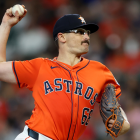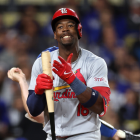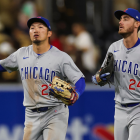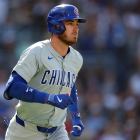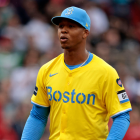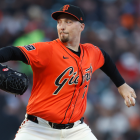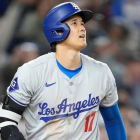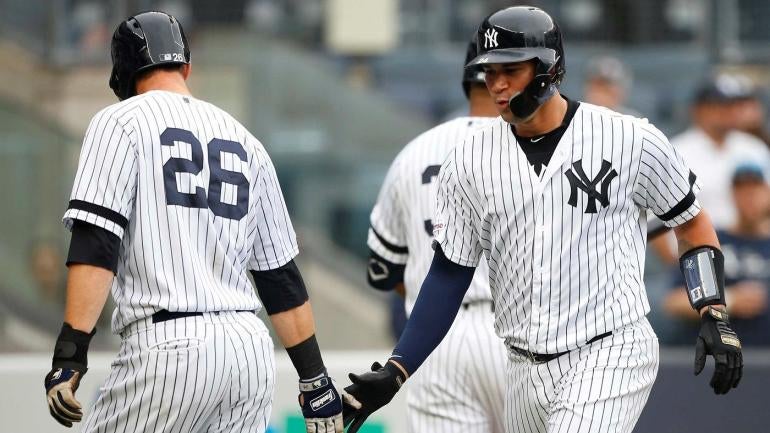
Another year, another disappointing -- and heartbreaking -- postseason exit for the New York Yankees. Friday night, the Yankees were eliminated in Game 5 of the American League Division Series by the division rival Rays (TB 2, NY 1). Mike Brosseau got the ultimate revenge with a go-ahead homer in the eighth inning off of Aroldis Chapman, five weeks after Chapman threw over his head.
Here is Brosseau's game-winning and series-clinching revenge home run:
Chapman, you may recall, surrendered a season-ending walk-off home run to Jose Altuve in Game 6 of last year's American League Championship Series. This is back-to-back years the Yankees had their season end because Chapman served up a back-breaking dinger. That's rough. Rajai Davis isn't the only player with a notable postseason homer against Chapman.
For the Yankees, there are two ways to look at this season. One, the Rays were the best team in the American League during the regular season and the Yankees went toe-to-toe with them in the ALDS. The series went the full five games and it came down to the final inning, essentially. The series was a coin flip. Not much had to play out differently for the Yankees to win.
"It was just a great back-and-forth series with another great team that has a chance to go win a world championship," Yankees manager Aaron Boone told reporters, including Greg Joyce of the New York Post, following Game 5. "It came down to basically the last inning of the series. I don't think anyone's surprised by that necessarily. We came up short."
And two, this is now four straight postseason disappointments since New York's new core emerged in 2017. They lost the 2017 ALCS in seven games, got crushed by the rival Red Sox in the 2018 ALDS, lost the 2019 ALCS on a walk-off homer, and lost the 2020 ALDS in five games on a late homer. The heartbreak has gotten worse each season.
The Yankees are a regular season powerhouse that has failed time and again in the postseason, and while failure is a strong word, it is the standard the Yankees set for themselves. No one in New York considers this objectively successful 2017-20 run satisfying even though there are about 25 MLB franchises that would take that four-year run in a heartbeat.
Where do the Yankees go from here? They're certainly good enough to contend next year with nothing more than minor tweaks this offseason, though minor tweaks may not be enough to get over the hump in the postseason. Three roster questions immediately come to mind as New York heads into the winter, plus there's a fourth question that should frame their decision-making.
1. What will it take to keep LeMahieu?
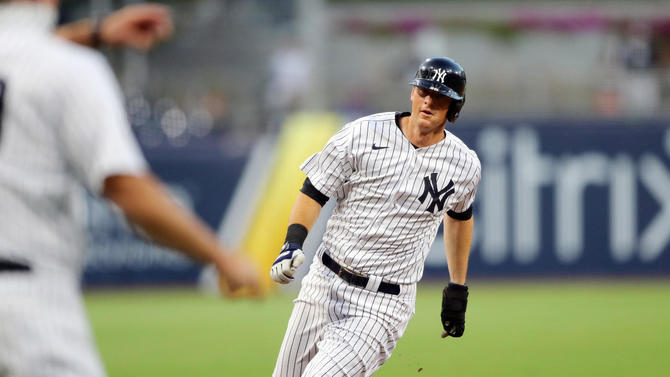
The Yankees landed the free agent bargain of the offseason two years ago when they signed DJ LeMahieu to a two-year contract worth a mere $24 million. He rewarded them with a .336/.386/.536 batting line and 8.8 WAR while playing three infield positions on the regular. Only six position players posted higher WAR than LeMahieu the last two years.
Although the ongoing COVID-19 pandemic has cut revenues and created financial uncertainty going forward, LeMahieu figures to be one of the few free agents who won't feel the squeeze this winter. He's an all-around impact player who is beloved by statheads (great exit velocities and contact rates) and scouts (tremendous instincts) alike. Even at age 32, LeMahieu is going to get paid.
"We've communicated in the past that we're going to worry about after the season," LeMahieu told reporters, including Kristie Ackert of the New York Daily News, when asked about contract extension talks earlier this week.
These are the Yankees and, pandemic or no pandemic, they can afford to pay any player any amount. LeMahieu is a perfect fit for their roster -- he's a perfect fit for every roster -- and the smart bet is the two sides will work out a new contract at some point. Perhaps before free agency, perhaps after he tests the waters, but at some point. It feels inevitable.
What will it cost? Mike Moustakas hit free agency at age 31 last year and signed a four-year contract worth $64 million. LeMahieu is a year older than Moustakas, but he's also the better player, so that feels like his contract floor. A four-year deal in the $80 million range seems more reasonable. Josh Donaldson's four-year, $92 million contract with the Twins is within reach, I'd say.
The alternatives to retaining LeMahieu include signing a second baseman (Tommy La Stella?) or signing a stopgap shortstop (Andrelton Simmons?) and moving Gleyber Torres back to second base. Francisco Lindor figures to be on the trade block again and he's one of the few players who might be an upgrade over LeMahieu, though LeMahieu was better the last two years.
It's not hard to look at New York's roster and think changes are required. More contact hitters, better rotation depth, so on and so forth. LeMahieu is one part of the roster that does not been to be changed. Bringing him back is a no-brainer and the Yankees will have to pay handsomely to keep him. He was a bargain the last two years. That's about to change.
2. Who's pitching for this team next year?
Gerrit Cole. We know that much. Lost in the Game 5 loss to the Rays was Cole's incredible performance on short rest. He held the Rays to one run on a solo homer in 5 1/3 innings while striking out nine and throwing 11 pitches at 99 mph or better, his most in a start this season. Many can be blamed for New York's postseason exit. Cole is absolutely not one of them.
The rotation behind Cole is currently unsettled. Longtime stalwart Masahiro Tanaka is a free agent -- doesn't the bidding war and subsequent seven-year contract feel like just yesterday? -- as is James Paxton, who was mostly a non-factor due to injury in 2020. J.A. Happ's contract includes a vesting option that probably didn't vest (the exact criteria is unknown), so he's a free agent too.
Right now, New York's starting rotation looks something like this:
- RHP Gerrit Cole (superstar of the first order)
- RHP Luis Severino (expected to return from Tommy John surgery in the middle of 2021)
- LHP Jordan Montgomery (inconsistent 2020 but generally solid)
- RHP Domingo German (missed 2020 while serving domestic violence policy suspension)
- RHP Deivi Garcia (impressive rookie who somehow threw only one inning in the five-game ALDS)
- RHP Michael King (serviceable swingman)
- RHP Clarke Schmidt (top prospect with limited experience above Single-A)
Yeah, there's room for improvement there. A reunion with Tanaka is possible if not likely -- Tanaka has made it no secret he loves being a Yankee and maybe that means he'd take a discount to stay -- but he's a mid-rotation starter these days, not a frontline guy. Trevor Bauer will be the best starter available in a thin free agent market and he's already sending out feelers.
Kinda looks like the @yankees could use some more starting pitching. Interesting.
— Trevor Bauer (@BauerOutage) October 8, 2020
As for the trade market, keep an eye on Carlos Carrasco. Cleveland is deep in young arms and Carrasco, whose 5-and-10 no-trade rights kick in next April, is owed $27 million from 2021-22, a pricey sum for a small market club. We've seen Cleveland trade Bauer, Mike Clevinger, and Corey Kluber within the last 15 months. Carrasco may be next and the Yankees have had interest in the past.
The Yankees need rotation help behind Cole, obviously. That's a top offseason priority. They also need bullpen help as well. Tommy Kahnle went down with Tommy John surgery in July and was an enormous loss. He was a go-to setup man who could neutralize righties and lefties and pitch in any scenario. The Yankees never replaced Kahnle and they really missed him in the postseason.
By the end of the ALDS it was clear Chapman, Zack Britton, and Chad Green were the only relievers in Boone's Circle of Trust™. Adam Ottavino had a disappointing regular season and his ineffectiveness against lefties made it difficult to find a soft landing spot for him against the pinch-hit happy Rays. Others like Jonathan Loaisiga and Jonathan Holder failed to emerge as reliable options.
The Yankees revamped their pitching development system last offseason -- Matt Blake, their rookie pitching coach, was hired away from Cleveland, where he helped develop Clevinger and Shane Bieber in recent years -- and they will bank on young arms moving forward, at least to some extent. They still need short-term help though. Cole is only one man.
3. With or without Sanchez?
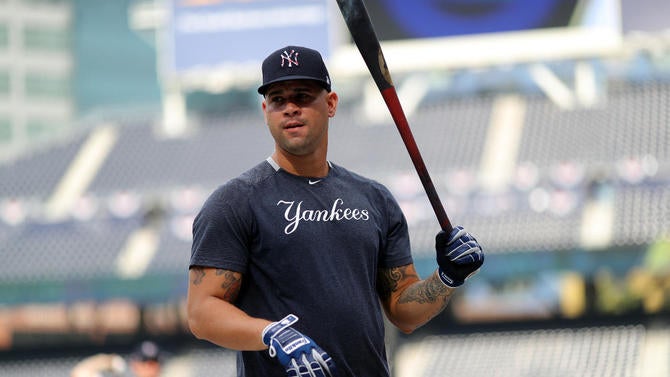
It was just last season that Gary Sanchez slugged 34 home runs and ranked sixth among all catchers in WAR. In 2020, Sanchez was among the worst players in baseball, hitting .147/.253/.365 with 64 strikeouts in 49 games. He was benched late in the regular season and again in the postseason. Backup Kyle Higashioka started four of the five games in the ALDS.
The question now is where do the Yankees and Sanchez go from here? Sanchez is still only 27 and he's a two-time All-Star, and he is under team control as an arbitration-eligible player through 2022. His trade value is way down at this point. Other teams would happily take him for pennies on the dollar, but Sanchez isn't going to headline a package for an impact starter right now.
Three years ago the Dodgers benched starting catcher Yasmani Grandal in the postseason -- he started two of their 15 postseason games in 2017 (Austin Barnes started the other 13) -- then Grandal came back, had a career year in 2018, and was their starter in the postseason. A postseason benching doesn't always mean the two sides will go their separate ways.
How strained is the relationship between the Yankees and Sanchez? Both sides have said all the right things publicly but we don't know how everyone feels behind closed doors. Sanchez may feel he needs a fresh start, the Yankees may feel they need a more steady presence behind the plate, so on and so forth. The catcher position is very much up in the air right now.
J.T. Realmuto is the game's best catcher and a free agent this winter, and signing him while dumping Sanchez is great sports radio fodder and perhaps an old school George Steinbrenner move. It remains to be seen whether the Yankees will jump into the deep end of the free agent pool though given the pandemic, their pitching needs, and LeMahieu's free agency.
The free agent catching market behind Realmuto isn't great. There's Jason Castro, whose lefty power would fit in Yankee Stadium, and James McCann, who might be a designated hitter more than a catcher given the poor defensive numbers he's posted in his career. Replacing Sanchez with another bat-first right-handed hitter kinda defeats the purpose, you know?
As bad as he was this year, Sanchez posted elite exit velocity (91.6 mph), hard-hit (49.5 percent), and barrel (17.4 percent) rates. Near the top of the league in each. Sanchez had a .159 batting average on balls in play this season, ninth lowest among the 26,958 individual player seasons since 1918 (min. 170 plate appearances) despite all the hard contact. That's hard to believe.
The historically low batting average on balls in play suggests there was some bad luck to Sanchez's season. It doesn't excuse the 36.0 percent strikeout rate or the defensive problems, but it's a reason to think he can be better going forward. Again, he is 27 and he was an All-Star last year. There are so few great catchers in this game right now and Sanchez can be one. We've seen it.
The Yankees have to decide what they want to do behind the plate. Retain Sanchez? Pursue Realmuto? Try something in the middle and cobble together a platoon? Personally, unless you're going to spend big for Realmuto, betting on Sanchez rebounding next year strikes me as the way to go. There's too much talent there to give up on him after this unusual pandemic season.
4. How much longer will the window remain open, really?
The Yankees, meaning ownership and the front office, have to take a look in the mirror and answer this question honestly. They are a huge market team, and money allows teams to remain in contention a long time, but the core is not as young as it once was. Or, rather, the core is not as cheap and under team control as long as it once was. Consider:
- Chad Green: Free agent after 2022.
- Aaron Judge: Free agent after 2022.
- Gary Sanchez: Free agent after 2022.
- Luis Severino: Free agent after 2022 (club option for 2023).
Torres is under team control through 2024, so he's still a long-term building block, otherwise the Baby Bombers aren't really babies anymore. They're getting expensive through arbitration and nearing free agency. On top of that, Giancarlo Stanton turns 31 in November, Cole turned 30 last month, and Chapman turns 33 in February. How much longer will they be in their primes?
To me, it seems like the Yankees have two more years to win with this core. Judge, Sanchez, and Severino will be free agents in two years -- who knows whether Sanchez will even stick around that long -- and Cole and Stanton are in their primes right now, but won't be forever. The best opportunity to win with this core is right now. Not two or three years down the line. It's right now.
That reality should factor into the team's decision-making. Of course the front office has to keep an eye on the big picture and the club's long-term future, but the short-term is very important too. The Yankees gave Cole a record contract last winter, but they did nothing else during the offseason, and they were inactive the last two trade deadlines despite glaring roster needs.
The possibility of not winning a World Series with this core after twice failing to address weaknesses at the deadline and having those weaknesses exposed in the postseason -- remember when the Yankees didn't have a starter for ALCS Game 6 last year and had to go with a bullpen game? -- would haunt me if I were the Yankees. Those are lost opportunities you can't get back.
This is all a long way of saying there should be a greater sense of urgency in the Bronx this offseason. Four straight disappointing postseason exits and a core that is either aging or coming up on free agency is a scary place to be. The window is not closed, but it is starting to close, and right now this organization has nothing to show for it. They should react appropriately.















